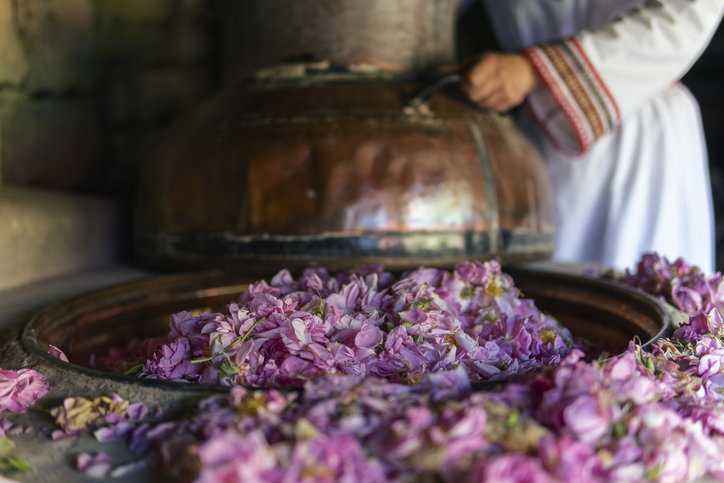ISO 9842:2003— Oil Of Rose

Rosa Damascena is the most widely used rose variety in perfumery. Classified in the rose family, Rosa Damascena rose essential oil is one of the best-known perfumery ingredients, as it is prized for the diffusion, sensual quality, and sweetness that it gives to a composition. Besides perfume, this high quality rose oil is also used in cosmetics, medicine, and food markets. ISO 9842:2003— Oil Of Rose (Rosa X Damascena Miller) covers characteristics of the oil of rose (Rosa ¥ damascena Miller).
Rosa Damascena
Rosa Damascena Mill is a perennial bushy shrub reaching approximately 1 to 2 meters in height with large, showy and colorful pink and red flowers. It is the hybrid between R. gallica and R. Phoenicia and is the member of Rosaceae family with more than 200 species and 18,000 cultivars around the world. R. damascena as the king of flowers has been the symbol of love, purity, faith, and beauty since the ancient times.
It was originated from Iran and essential oil extracting from its flowers has been started since 7th century A.D. R. damascena is traditionally used as form of medicine for treatment of abdominal and chest pains, strengthening the heart, menstrual bleeding, digestive problems, and constipation. It was brought to Europe and has been cultivated in European countries. Nowadays, Bulgaria and Turkey are the main producers of R. damascena essential oil in the world, and the Bulgarian R. damascena oil is the known best ones.
What Is ISO 9842?
ISO 9842:2003 specifies certain characteristics of the oil of rose (Rosa x damascena Miller) cultivated in Turkey, Morocco and Bulgaria, of the Rosaceae family, in order to facilitate assessment of its quality. The standard details that analysis of the essential oil should be carried out by gas chromatography. In the chromatogram obtained, the representative and characteristic components—ethanol, citronellol, nerol, geraniol, phenylethanol, heptadecane (Paraffin C17) , nonadecane (Paraffin C19), and heneicosane (Paraffin C21)— should be identified. ISO 9842:2003 maintains that the proportions of these components, indicated by the integrator, should align with the chromatographic profile of the essential oil.
Why Do Roses Symbolize Love?
Throughout the history of roses, in Ancient Greece, the Roman Empire, and the Middle Ages, the flower has symbolized love, beauty, power, and passion.
Ancient Greece
One of the first recorded instances of roses representing love comes from ancient Greek mythology. Aphrodite, the Goddess of Love, Beauty, and Sexuality, walked through a rose garden that had been shot with an arrow by Cupid. The roses had grown thorns thanks to Cupid’s arrow. Aphrodite pricked her thorn on a rose and her blood turned roses red. Further, according to another story of Greek mythology, Aphrodite’s beauty was so vast that roses sprang up wherever she walked. As a result, red roses became a symbol of love and desire, and they were often used in romantic gestures and rituals.
Red roses were also associated with Adonis, the Greek god of beauty and desire. According to mythology, Adonis was killed by a wild boar while hunting, and his blood stained the white roses that grew around him, turning them red. Thus, red roses became a symbol of sacrifice and passion.
Ancient Rome
In Ancient Rome, red roses were used as a symbol of power and authority. They were often used in official ceremonies and given as gifts to honor or show respect to important figures. Roman emperors were also known for filling their bathtubs with rose petals and using them as confetti for celebrations. Their pleasant-smelling fragrance graced many Romans’ rooms and continued adding to the love and desire meaning behind roses.

Moreover, the origins of Valentine’s Day can be traced back to the ancient Roman celebration of Lupercalia. Held on February 15, Lupercalia honored the gods Lupercus and Faunus, as well as the legendary founders of Rome, Romulus and Remus. In addition to a bountiful feast, Lupercalia festivities are purported to have included the pairing of young women and men. While this pairing of couples set the tone for today’s holiday, it was not called “Valentine’s Day” until a priest named Valentine came along. Valentine, a romantic at heart, disobeyed Emperor Claudius II’s decree that soldiers remain bachelors. Claudius handed down this decree believing that soldiers would be distracted and unable to concentrate on fighting if they were married or engaged. Valentine defied the emperor and secretly performed marriage ceremonies. As a result of his defiance, Valentine was put to death on February 14. Saint Valentine’s Day, also known as Valentine’s Day or the Feast of Saint Valentine, is observed on February 14th each year. It is celebrated in many countries around the world, although it remains a working day in most of them.
A popular account of Saint Valentine of Rome states that he was imprisoned for performing weddings for soldiers who were forbidden to marry and for ministering to Christians, who were persecuted under the Roman Empire. According to legend, during his imprisonment, he healed the daughter of his jailer, Asterius. An embellishment to this story states that before his execution he wrote her a letter signed “Your Valentine” as a farewell.
Middle Ages
During the Middle Ages (~500 AD to 1500), the rose bloomed as a symbol of love and passion. Red roses were meant to be given by knights to their ladies, and they were often used in poetry to describe a woman’s beauty. The color red itself was associated with purity, innocence, and virginity – symbols attached to the Virgin Mary. Red roses as a symbol of sacrifice and passion were often used in religious ceremonies to represent the suffering of Christ.
In the 14th and 15th centuries, Valentine’s Day became more commercialized as merchants and traders began selling cards, flowers, and other gifts to celebrate the holiday. William Shakespeare also helped romanticize Valentine’s Day in his work, and it gained popularity throughout Britain and the rest of Europe. The red rose became particularly popular as a symbol of love and passion.
Commercial Derivations of Rosa Damascena
The bushes of R. damascena flowers bloom once a year, from May to June. The flowers are picked by hand daily at early morning, then distilled or extracted within 24 hours. for industrial purposes. Different commercial products are produced from R. Damascena:
- Rose essential oil: (or liquid gold) is expensive yellow pale essential oil that is extracted by different commercial methods. Because of the low oil content in R. damascena and the lack of natural and synthetic substitutes, essential rose oil of this plant is one of the most expensive ones in the world markets.
- Rose water: The fragrant liquid distilled from fresh rose petals. It is a pantry staple throughout the Mediterranean and Middle East as just a dash adds a delicate floral quality to both sweet and savory foods. Additionally, as a symbol of love and purity, rose water is sometimes scattered at weddings to ensure a happy marriage and can also be used to aid meditation and prayer.
- Dried flowers: The dried buds and petals of rose are sold in groceries as flavor and laxative agents. In Iran, dried flowers are used as laxative agent and flavoring in foods.
- Rose hips: Are the berry like fruits under the petals of flower. They are rich of vitamins, minerals and fatty acids, polyphenols, carotenoids and tannins. The vitamin C content of rose hips is higher than citrus fruits.
- Rose concrete: A red orange waxy mass that is extracted by non-polar solvent extraction and is the main material for production of rose absolute.
- Rose absolute: The ethanol extract of rose concrete that has an orange red liquid with rose aroma
ISO 9842:2003— Oil Of Rose (Rosa X Damascena Miller) is available on the ANSI Webstore.






